ACCT19083 Corporate Governance and Ethics Assignment Term 2, 2019
VerifiedAdded on 2022/10/01
|15
|5550
|332
Homework Assignment
AI Summary
This assignment solution for ACCT19083 Corporate Governance and Ethics explores several key ethical concepts within a business context. Part A, Question 1, analyzes a scenario using the consequentialist theory of utilitarianism, explaining Arnold's motivation to disclose short payments based on maximizing overall good. Question 2 delves into the limits of loyalty, arguing against unconditional loyalty and emphasizing the importance of ethical considerations and the law of agency. It examines whether Mr. Goodrich is right to expect loyalty from Arnold. Question 3 applies Kaptein's dimensions of an ethical culture to a provided business scenario, evaluating the company's ethical culture and highlighting the absence of key ethical elements, such as ethical role modeling and openness. The assignment demonstrates an understanding of ethical theories, the complexities of workplace loyalty, and the importance of a strong ethical culture within an organization.
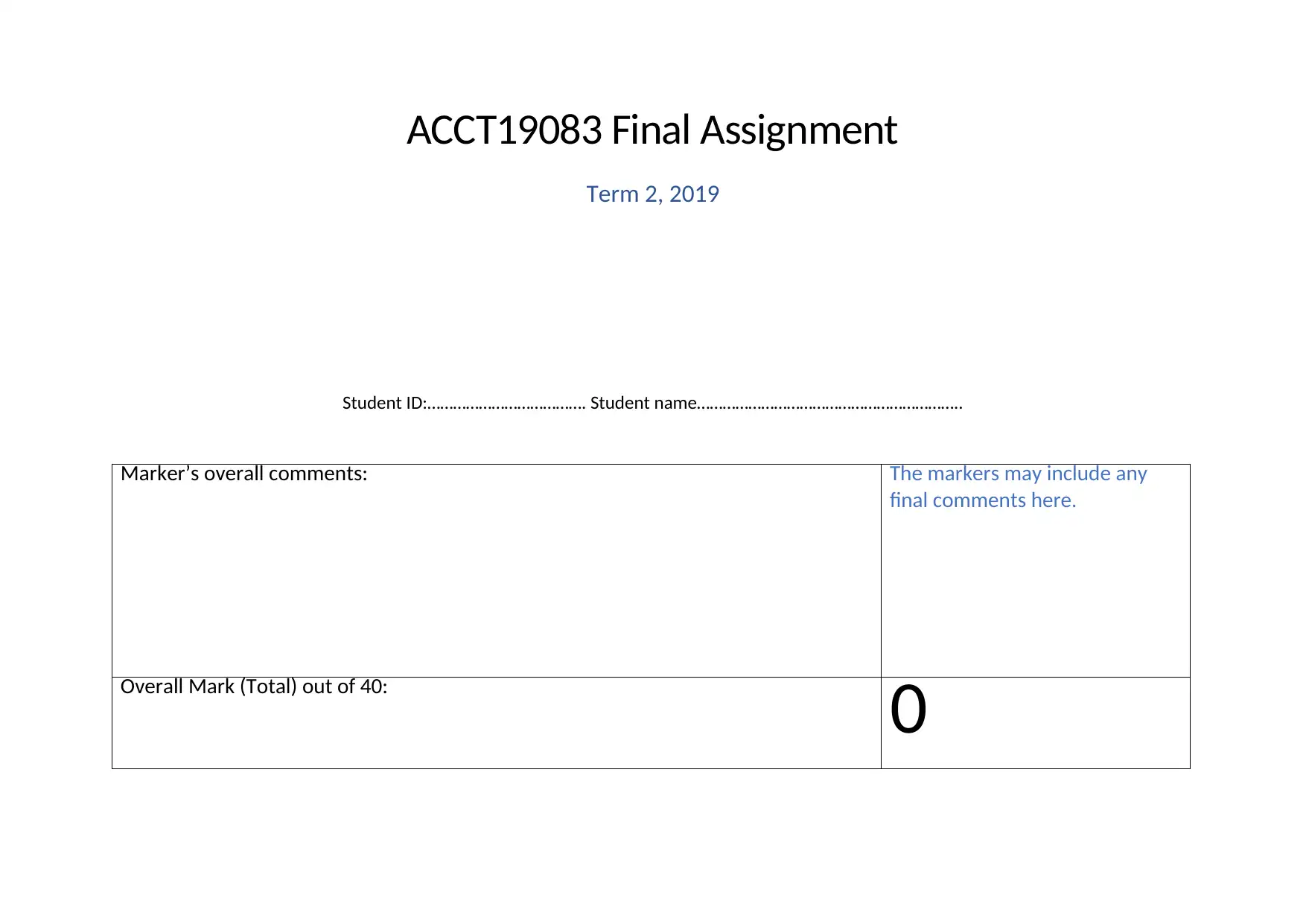
ACCT19083 Final Assignment
Term 2, 2019
Student ID:………………………………. Student name……………………………………………………..
Marker’s overall comments: The markers may include any
final comments here.
Overall Mark (Total) out of 40:
0
Term 2, 2019
Student ID:………………………………. Student name……………………………………………………..
Marker’s overall comments: The markers may include any
final comments here.
Overall Mark (Total) out of 40:
0
Paraphrase This Document
Need a fresh take? Get an instant paraphrase of this document with our AI Paraphraser


⊘ This is a preview!⊘
Do you want full access?
Subscribe today to unlock all pages.

Trusted by 1+ million students worldwide
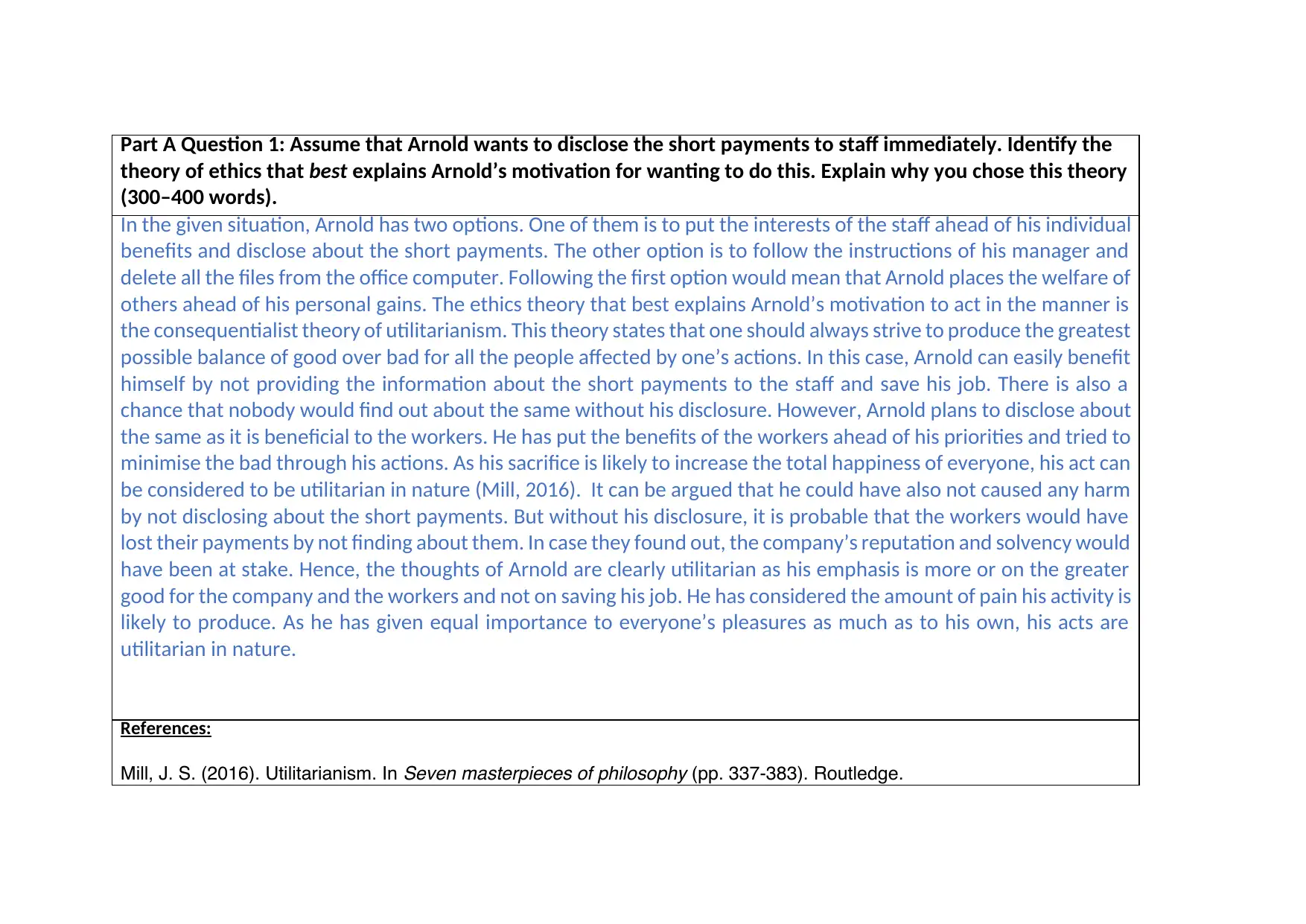
Part A Question 1: Assume that Arnold wants to disclose the short payments to staff immediately. Identify the
theory of ethics that best explains Arnold’s motivation for wanting to do this. Explain why you chose this theory
(300–400 words).
In the given situation, Arnold has two options. One of them is to put the interests of the staff ahead of his individual
benefits and disclose about the short payments. The other option is to follow the instructions of his manager and
delete all the files from the office computer. Following the first option would mean that Arnold places the welfare of
others ahead of his personal gains. The ethics theory that best explains Arnold’s motivation to act in the manner is
the consequentialist theory of utilitarianism. This theory states that one should always strive to produce the greatest
possible balance of good over bad for all the people affected by one’s actions. In this case, Arnold can easily benefit
himself by not providing the information about the short payments to the staff and save his job. There is also a
chance that nobody would find out about the same without his disclosure. However, Arnold plans to disclose about
the same as it is beneficial to the workers. He has put the benefits of the workers ahead of his priorities and tried to
minimise the bad through his actions. As his sacrifice is likely to increase the total happiness of everyone, his act can
be considered to be utilitarian in nature (Mill, 2016). It can be argued that he could have also not caused any harm
by not disclosing about the short payments. But without his disclosure, it is probable that the workers would have
lost their payments by not finding about them. In case they found out, the company’s reputation and solvency would
have been at stake. Hence, the thoughts of Arnold are clearly utilitarian as his emphasis is more or on the greater
good for the company and the workers and not on saving his job. He has considered the amount of pain his activity is
likely to produce. As he has given equal importance to everyone’s pleasures as much as to his own, his acts are
utilitarian in nature.
References:
Mill, J. S. (2016). Utilitarianism. In Seven masterpieces of philosophy (pp. 337-383). Routledge.
theory of ethics that best explains Arnold’s motivation for wanting to do this. Explain why you chose this theory
(300–400 words).
In the given situation, Arnold has two options. One of them is to put the interests of the staff ahead of his individual
benefits and disclose about the short payments. The other option is to follow the instructions of his manager and
delete all the files from the office computer. Following the first option would mean that Arnold places the welfare of
others ahead of his personal gains. The ethics theory that best explains Arnold’s motivation to act in the manner is
the consequentialist theory of utilitarianism. This theory states that one should always strive to produce the greatest
possible balance of good over bad for all the people affected by one’s actions. In this case, Arnold can easily benefit
himself by not providing the information about the short payments to the staff and save his job. There is also a
chance that nobody would find out about the same without his disclosure. However, Arnold plans to disclose about
the same as it is beneficial to the workers. He has put the benefits of the workers ahead of his priorities and tried to
minimise the bad through his actions. As his sacrifice is likely to increase the total happiness of everyone, his act can
be considered to be utilitarian in nature (Mill, 2016). It can be argued that he could have also not caused any harm
by not disclosing about the short payments. But without his disclosure, it is probable that the workers would have
lost their payments by not finding about them. In case they found out, the company’s reputation and solvency would
have been at stake. Hence, the thoughts of Arnold are clearly utilitarian as his emphasis is more or on the greater
good for the company and the workers and not on saving his job. He has considered the amount of pain his activity is
likely to produce. As he has given equal importance to everyone’s pleasures as much as to his own, his acts are
utilitarian in nature.
References:
Mill, J. S. (2016). Utilitarianism. In Seven masterpieces of philosophy (pp. 337-383). Routledge.
Paraphrase This Document
Need a fresh take? Get an instant paraphrase of this document with our AI Paraphraser

Marker’s Comments: The marker will provide feedback here. Mark (5):
0
Exceeds Expectations
(High Distinction) 85-100%
Exceeds Expectations
(Distinction) 75 - 84%
Meets Expectations
(Credit) 65 – 74%
Meets Expectations
(Pass) 50 – 64%
Below Expectations
(Fail) below 50%
Demonstrates a balanced and very
high level of detailed knowledge of
core concepts by providing a very
high level of analysis. Utilises
current, appropriate and credible
sources.
Demonstrates a balanced and high
level of knowledge of core
concepts by providing a high level
of analysis. Utilises mostly current,
appropriate and credible sources.
Demonstrates a good level of
knowledge of some of the core
concepts by providing some level
of analysis. Utilises some current,
appropriate and credible sources.
Demonstrates limited knowledge of
core concepts by providing a
limited level of analysis. Utilises
few current, appropriate and
credible sources.
Demonstrates little, if any,
knowledge of the core concepts
with extremely limited, if any,
analysis. Utilises little, if any,
current, appropriate and credible
sources.
Quality of writing at a very high
standard. Paragraphs are
coherently connected to each
other. Correct grammar, spelling
and punctuation.
Quality of writing is of a high
standard. Paragraphs are mostly
well structured. Few grammar,
spelling and punctuation mistakes.
Quality of writing is of a good
standard. Few grammar, spelling
and punctuation mistakes.
Some problems with sentence
structure and presentation
Frequent grammar, punctuation
and spelling mistakes. Use of
inappropriate language.
Quality of writing is at a very poor
standard so barely
understandable. Many spelling
mistakes. Little or no evidence of
proof reading.
The assessment presents a
detailed and focused summary of
the ideas presented; drawing clear
and well thought-out conclusions.
The assessment presents a fairly
detailed and focused summary of
the ideas presented; drawing fairly
clear and well thought-out
conclusions.
The assessment presents a
somewhat detailed and focused
summary of the ideas presented;
providing some evidence of
conclusions.
The assessment provides limited
detail with no clear summary of the
ideas presented; drawing limited
conclusions.
The assessment fails to provide
any clear evidence of the ideas
presented; drawing no clear
conclusions.
0
Exceeds Expectations
(High Distinction) 85-100%
Exceeds Expectations
(Distinction) 75 - 84%
Meets Expectations
(Credit) 65 – 74%
Meets Expectations
(Pass) 50 – 64%
Below Expectations
(Fail) below 50%
Demonstrates a balanced and very
high level of detailed knowledge of
core concepts by providing a very
high level of analysis. Utilises
current, appropriate and credible
sources.
Demonstrates a balanced and high
level of knowledge of core
concepts by providing a high level
of analysis. Utilises mostly current,
appropriate and credible sources.
Demonstrates a good level of
knowledge of some of the core
concepts by providing some level
of analysis. Utilises some current,
appropriate and credible sources.
Demonstrates limited knowledge of
core concepts by providing a
limited level of analysis. Utilises
few current, appropriate and
credible sources.
Demonstrates little, if any,
knowledge of the core concepts
with extremely limited, if any,
analysis. Utilises little, if any,
current, appropriate and credible
sources.
Quality of writing at a very high
standard. Paragraphs are
coherently connected to each
other. Correct grammar, spelling
and punctuation.
Quality of writing is of a high
standard. Paragraphs are mostly
well structured. Few grammar,
spelling and punctuation mistakes.
Quality of writing is of a good
standard. Few grammar, spelling
and punctuation mistakes.
Some problems with sentence
structure and presentation
Frequent grammar, punctuation
and spelling mistakes. Use of
inappropriate language.
Quality of writing is at a very poor
standard so barely
understandable. Many spelling
mistakes. Little or no evidence of
proof reading.
The assessment presents a
detailed and focused summary of
the ideas presented; drawing clear
and well thought-out conclusions.
The assessment presents a fairly
detailed and focused summary of
the ideas presented; drawing fairly
clear and well thought-out
conclusions.
The assessment presents a
somewhat detailed and focused
summary of the ideas presented;
providing some evidence of
conclusions.
The assessment provides limited
detail with no clear summary of the
ideas presented; drawing limited
conclusions.
The assessment fails to provide
any clear evidence of the ideas
presented; drawing no clear
conclusions.
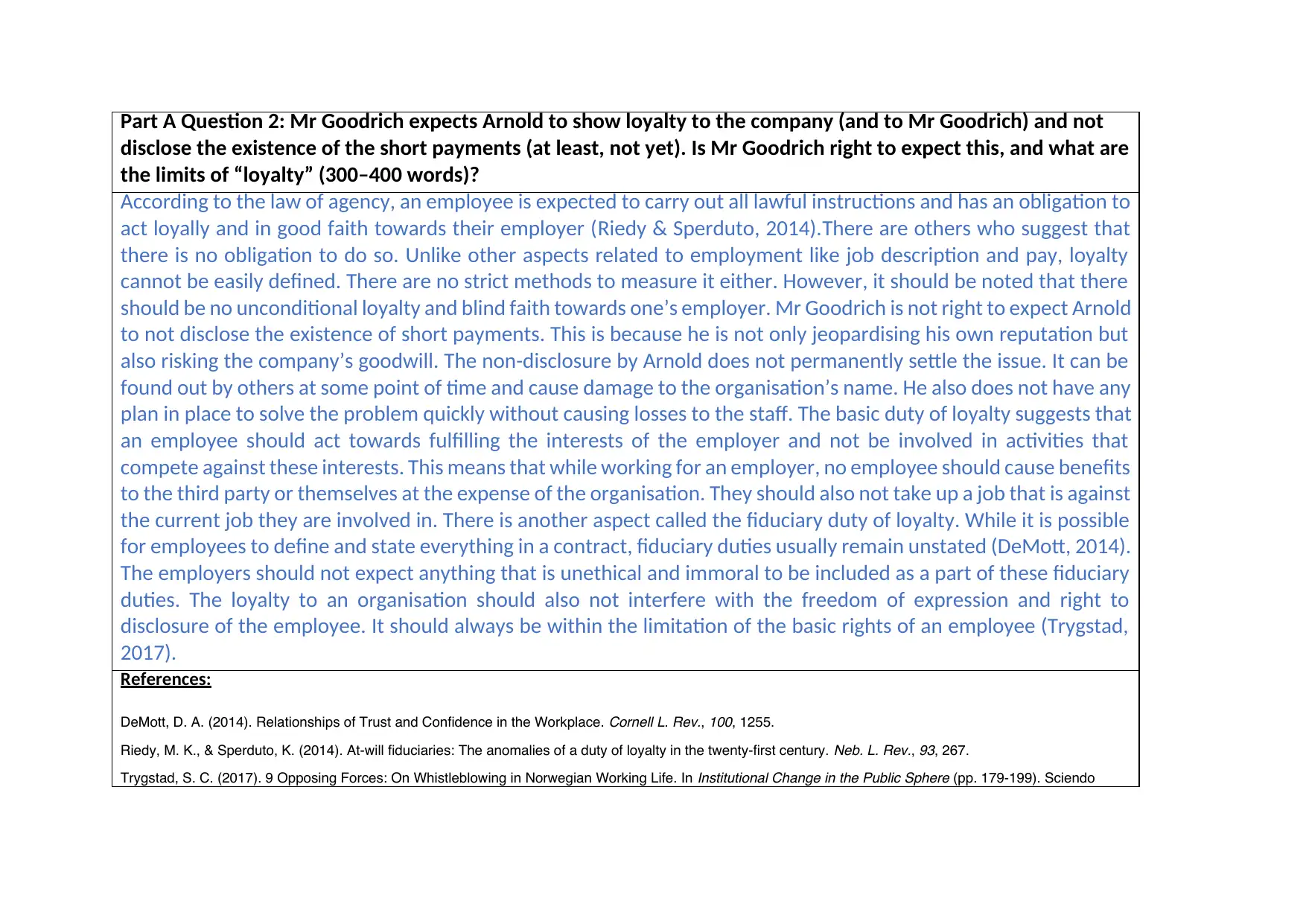
Part A Question 2: Mr Goodrich expects Arnold to show loyalty to the company (and to Mr Goodrich) and not
disclose the existence of the short payments (at least, not yet). Is Mr Goodrich right to expect this, and what are
the limits of “loyalty” (300–400 words)?
According to the law of agency, an employee is expected to carry out all lawful instructions and has an obligation to
act loyally and in good faith towards their employer (Riedy & Sperduto, 2014).There are others who suggest that
there is no obligation to do so. Unlike other aspects related to employment like job description and pay, loyalty
cannot be easily defined. There are no strict methods to measure it either. However, it should be noted that there
should be no unconditional loyalty and blind faith towards one’s employer. Mr Goodrich is not right to expect Arnold
to not disclose the existence of short payments. This is because he is not only jeopardising his own reputation but
also risking the company’s goodwill. The non-disclosure by Arnold does not permanently settle the issue. It can be
found out by others at some point of time and cause damage to the organisation’s name. He also does not have any
plan in place to solve the problem quickly without causing losses to the staff. The basic duty of loyalty suggests that
an employee should act towards fulfilling the interests of the employer and not be involved in activities that
compete against these interests. This means that while working for an employer, no employee should cause benefits
to the third party or themselves at the expense of the organisation. They should also not take up a job that is against
the current job they are involved in. There is another aspect called the fiduciary duty of loyalty. While it is possible
for employees to define and state everything in a contract, fiduciary duties usually remain unstated (DeMott, 2014).
The employers should not expect anything that is unethical and immoral to be included as a part of these fiduciary
duties. The loyalty to an organisation should also not interfere with the freedom of expression and right to
disclosure of the employee. It should always be within the limitation of the basic rights of an employee (Trygstad,
2017).
References:
DeMott, D. A. (2014). Relationships of Trust and Confidence in the Workplace. Cornell L. Rev., 100, 1255.
Riedy, M. K., & Sperduto, K. (2014). At-will fiduciaries: The anomalies of a duty of loyalty in the twenty-first century. Neb. L. Rev., 93, 267.
Trygstad, S. C. (2017). 9 Opposing Forces: On Whistleblowing in Norwegian Working Life. In Institutional Change in the Public Sphere (pp. 179-199). Sciendo
disclose the existence of the short payments (at least, not yet). Is Mr Goodrich right to expect this, and what are
the limits of “loyalty” (300–400 words)?
According to the law of agency, an employee is expected to carry out all lawful instructions and has an obligation to
act loyally and in good faith towards their employer (Riedy & Sperduto, 2014).There are others who suggest that
there is no obligation to do so. Unlike other aspects related to employment like job description and pay, loyalty
cannot be easily defined. There are no strict methods to measure it either. However, it should be noted that there
should be no unconditional loyalty and blind faith towards one’s employer. Mr Goodrich is not right to expect Arnold
to not disclose the existence of short payments. This is because he is not only jeopardising his own reputation but
also risking the company’s goodwill. The non-disclosure by Arnold does not permanently settle the issue. It can be
found out by others at some point of time and cause damage to the organisation’s name. He also does not have any
plan in place to solve the problem quickly without causing losses to the staff. The basic duty of loyalty suggests that
an employee should act towards fulfilling the interests of the employer and not be involved in activities that
compete against these interests. This means that while working for an employer, no employee should cause benefits
to the third party or themselves at the expense of the organisation. They should also not take up a job that is against
the current job they are involved in. There is another aspect called the fiduciary duty of loyalty. While it is possible
for employees to define and state everything in a contract, fiduciary duties usually remain unstated (DeMott, 2014).
The employers should not expect anything that is unethical and immoral to be included as a part of these fiduciary
duties. The loyalty to an organisation should also not interfere with the freedom of expression and right to
disclosure of the employee. It should always be within the limitation of the basic rights of an employee (Trygstad,
2017).
References:
DeMott, D. A. (2014). Relationships of Trust and Confidence in the Workplace. Cornell L. Rev., 100, 1255.
Riedy, M. K., & Sperduto, K. (2014). At-will fiduciaries: The anomalies of a duty of loyalty in the twenty-first century. Neb. L. Rev., 93, 267.
Trygstad, S. C. (2017). 9 Opposing Forces: On Whistleblowing in Norwegian Working Life. In Institutional Change in the Public Sphere (pp. 179-199). Sciendo
⊘ This is a preview!⊘
Do you want full access?
Subscribe today to unlock all pages.

Trusted by 1+ million students worldwide
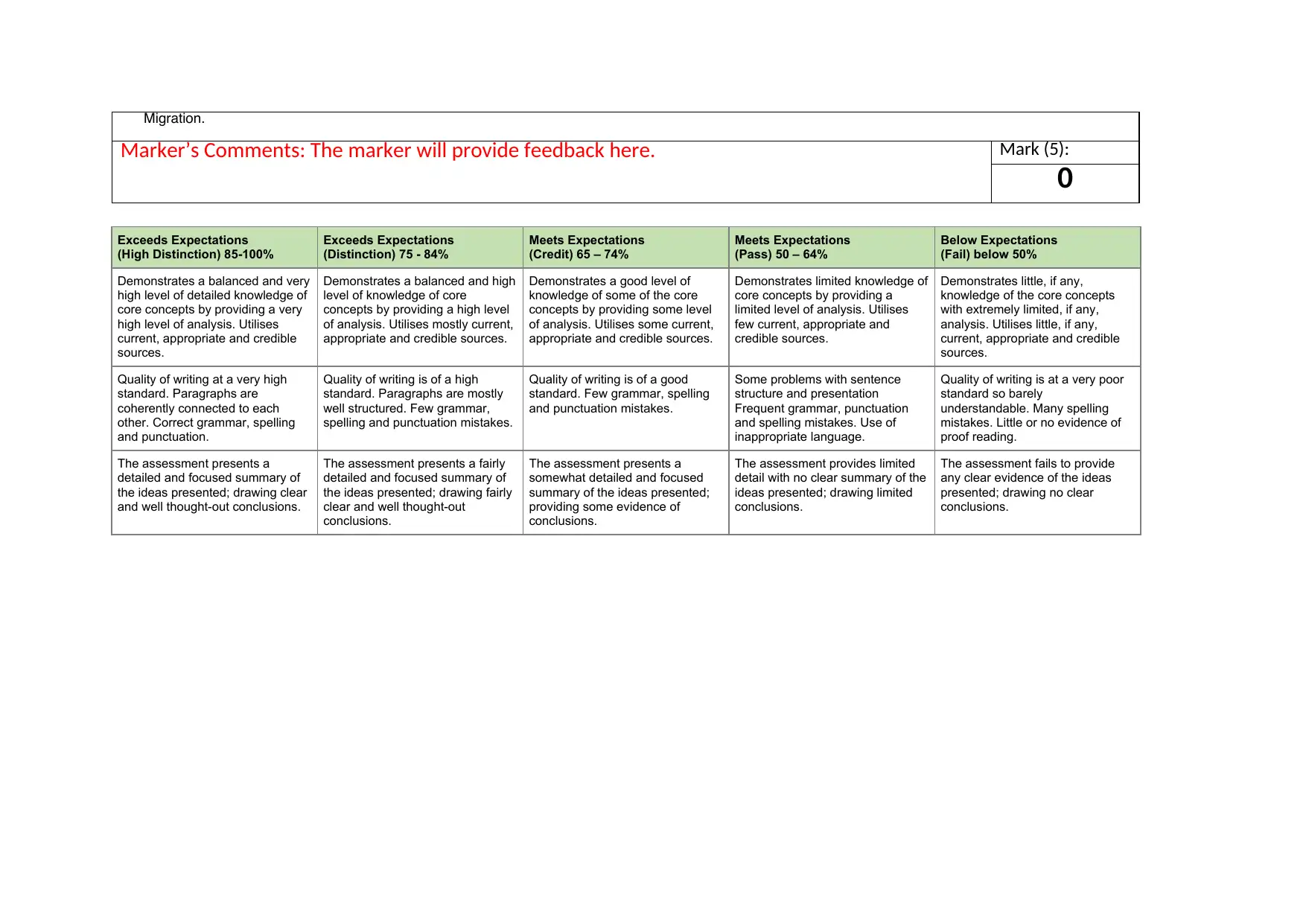
Migration.
Marker’s Comments: The marker will provide feedback here. Mark (5):
0
Exceeds Expectations
(High Distinction) 85-100%
Exceeds Expectations
(Distinction) 75 - 84%
Meets Expectations
(Credit) 65 – 74%
Meets Expectations
(Pass) 50 – 64%
Below Expectations
(Fail) below 50%
Demonstrates a balanced and very
high level of detailed knowledge of
core concepts by providing a very
high level of analysis. Utilises
current, appropriate and credible
sources.
Demonstrates a balanced and high
level of knowledge of core
concepts by providing a high level
of analysis. Utilises mostly current,
appropriate and credible sources.
Demonstrates a good level of
knowledge of some of the core
concepts by providing some level
of analysis. Utilises some current,
appropriate and credible sources.
Demonstrates limited knowledge of
core concepts by providing a
limited level of analysis. Utilises
few current, appropriate and
credible sources.
Demonstrates little, if any,
knowledge of the core concepts
with extremely limited, if any,
analysis. Utilises little, if any,
current, appropriate and credible
sources.
Quality of writing at a very high
standard. Paragraphs are
coherently connected to each
other. Correct grammar, spelling
and punctuation.
Quality of writing is of a high
standard. Paragraphs are mostly
well structured. Few grammar,
spelling and punctuation mistakes.
Quality of writing is of a good
standard. Few grammar, spelling
and punctuation mistakes.
Some problems with sentence
structure and presentation
Frequent grammar, punctuation
and spelling mistakes. Use of
inappropriate language.
Quality of writing is at a very poor
standard so barely
understandable. Many spelling
mistakes. Little or no evidence of
proof reading.
The assessment presents a
detailed and focused summary of
the ideas presented; drawing clear
and well thought-out conclusions.
The assessment presents a fairly
detailed and focused summary of
the ideas presented; drawing fairly
clear and well thought-out
conclusions.
The assessment presents a
somewhat detailed and focused
summary of the ideas presented;
providing some evidence of
conclusions.
The assessment provides limited
detail with no clear summary of the
ideas presented; drawing limited
conclusions.
The assessment fails to provide
any clear evidence of the ideas
presented; drawing no clear
conclusions.
Marker’s Comments: The marker will provide feedback here. Mark (5):
0
Exceeds Expectations
(High Distinction) 85-100%
Exceeds Expectations
(Distinction) 75 - 84%
Meets Expectations
(Credit) 65 – 74%
Meets Expectations
(Pass) 50 – 64%
Below Expectations
(Fail) below 50%
Demonstrates a balanced and very
high level of detailed knowledge of
core concepts by providing a very
high level of analysis. Utilises
current, appropriate and credible
sources.
Demonstrates a balanced and high
level of knowledge of core
concepts by providing a high level
of analysis. Utilises mostly current,
appropriate and credible sources.
Demonstrates a good level of
knowledge of some of the core
concepts by providing some level
of analysis. Utilises some current,
appropriate and credible sources.
Demonstrates limited knowledge of
core concepts by providing a
limited level of analysis. Utilises
few current, appropriate and
credible sources.
Demonstrates little, if any,
knowledge of the core concepts
with extremely limited, if any,
analysis. Utilises little, if any,
current, appropriate and credible
sources.
Quality of writing at a very high
standard. Paragraphs are
coherently connected to each
other. Correct grammar, spelling
and punctuation.
Quality of writing is of a high
standard. Paragraphs are mostly
well structured. Few grammar,
spelling and punctuation mistakes.
Quality of writing is of a good
standard. Few grammar, spelling
and punctuation mistakes.
Some problems with sentence
structure and presentation
Frequent grammar, punctuation
and spelling mistakes. Use of
inappropriate language.
Quality of writing is at a very poor
standard so barely
understandable. Many spelling
mistakes. Little or no evidence of
proof reading.
The assessment presents a
detailed and focused summary of
the ideas presented; drawing clear
and well thought-out conclusions.
The assessment presents a fairly
detailed and focused summary of
the ideas presented; drawing fairly
clear and well thought-out
conclusions.
The assessment presents a
somewhat detailed and focused
summary of the ideas presented;
providing some evidence of
conclusions.
The assessment provides limited
detail with no clear summary of the
ideas presented; drawing limited
conclusions.
The assessment fails to provide
any clear evidence of the ideas
presented; drawing no clear
conclusions.
Paraphrase This Document
Need a fresh take? Get an instant paraphrase of this document with our AI Paraphraser
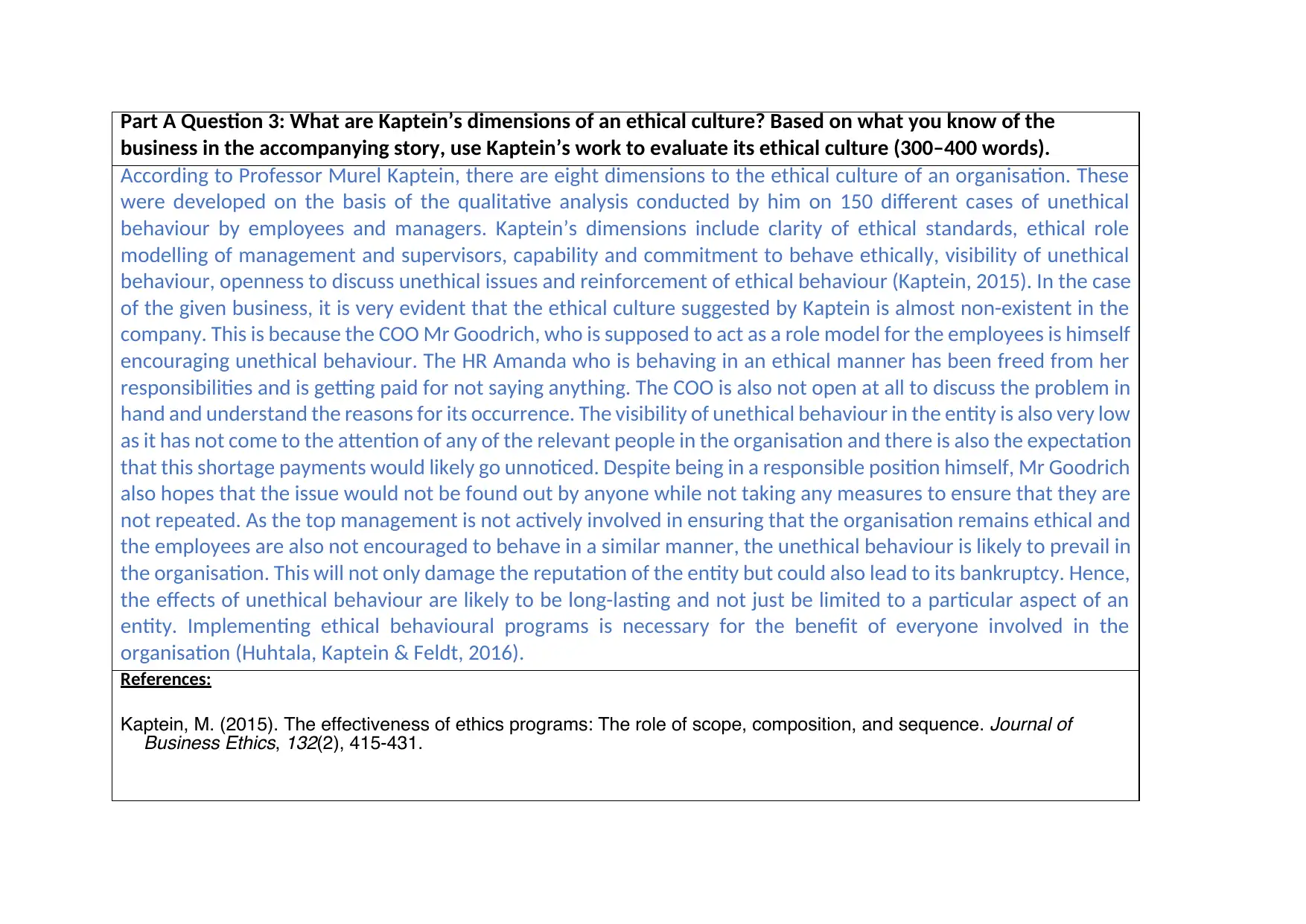
Part A Question 3: What are Kaptein’s dimensions of an ethical culture? Based on what you know of the
business in the accompanying story, use Kaptein’s work to evaluate its ethical culture (300–400 words).
According to Professor Murel Kaptein, there are eight dimensions to the ethical culture of an organisation. These
were developed on the basis of the qualitative analysis conducted by him on 150 different cases of unethical
behaviour by employees and managers. Kaptein’s dimensions include clarity of ethical standards, ethical role
modelling of management and supervisors, capability and commitment to behave ethically, visibility of unethical
behaviour, openness to discuss unethical issues and reinforcement of ethical behaviour (Kaptein, 2015). In the case
of the given business, it is very evident that the ethical culture suggested by Kaptein is almost non-existent in the
company. This is because the COO Mr Goodrich, who is supposed to act as a role model for the employees is himself
encouraging unethical behaviour. The HR Amanda who is behaving in an ethical manner has been freed from her
responsibilities and is getting paid for not saying anything. The COO is also not open at all to discuss the problem in
hand and understand the reasons for its occurrence. The visibility of unethical behaviour in the entity is also very low
as it has not come to the attention of any of the relevant people in the organisation and there is also the expectation
that this shortage payments would likely go unnoticed. Despite being in a responsible position himself, Mr Goodrich
also hopes that the issue would not be found out by anyone while not taking any measures to ensure that they are
not repeated. As the top management is not actively involved in ensuring that the organisation remains ethical and
the employees are also not encouraged to behave in a similar manner, the unethical behaviour is likely to prevail in
the organisation. This will not only damage the reputation of the entity but could also lead to its bankruptcy. Hence,
the effects of unethical behaviour are likely to be long-lasting and not just be limited to a particular aspect of an
entity. Implementing ethical behavioural programs is necessary for the benefit of everyone involved in the
organisation (Huhtala, Kaptein & Feldt, 2016).
References:
Kaptein, M. (2015). The effectiveness of ethics programs: The role of scope, composition, and sequence. Journal of
Business Ethics, 132(2), 415-431.
business in the accompanying story, use Kaptein’s work to evaluate its ethical culture (300–400 words).
According to Professor Murel Kaptein, there are eight dimensions to the ethical culture of an organisation. These
were developed on the basis of the qualitative analysis conducted by him on 150 different cases of unethical
behaviour by employees and managers. Kaptein’s dimensions include clarity of ethical standards, ethical role
modelling of management and supervisors, capability and commitment to behave ethically, visibility of unethical
behaviour, openness to discuss unethical issues and reinforcement of ethical behaviour (Kaptein, 2015). In the case
of the given business, it is very evident that the ethical culture suggested by Kaptein is almost non-existent in the
company. This is because the COO Mr Goodrich, who is supposed to act as a role model for the employees is himself
encouraging unethical behaviour. The HR Amanda who is behaving in an ethical manner has been freed from her
responsibilities and is getting paid for not saying anything. The COO is also not open at all to discuss the problem in
hand and understand the reasons for its occurrence. The visibility of unethical behaviour in the entity is also very low
as it has not come to the attention of any of the relevant people in the organisation and there is also the expectation
that this shortage payments would likely go unnoticed. Despite being in a responsible position himself, Mr Goodrich
also hopes that the issue would not be found out by anyone while not taking any measures to ensure that they are
not repeated. As the top management is not actively involved in ensuring that the organisation remains ethical and
the employees are also not encouraged to behave in a similar manner, the unethical behaviour is likely to prevail in
the organisation. This will not only damage the reputation of the entity but could also lead to its bankruptcy. Hence,
the effects of unethical behaviour are likely to be long-lasting and not just be limited to a particular aspect of an
entity. Implementing ethical behavioural programs is necessary for the benefit of everyone involved in the
organisation (Huhtala, Kaptein & Feldt, 2016).
References:
Kaptein, M. (2015). The effectiveness of ethics programs: The role of scope, composition, and sequence. Journal of
Business Ethics, 132(2), 415-431.

Huhtala, M., Kaptein, M., & Feldt, T. (2016). How perceived changes in the ethical culture of organizations influence the
well-being of managers: A two-year longitudinal study. European Journal of Work and Organizational
Psychology, 25(3), 335-352.
Marker’s Comments: The marker will provide feedback here. Mark (5):
0
Exceeds Expectations
(High Distinction) 85-100%
Exceeds Expectations
(Distinction) 75 - 84%
Meets Expectations
(Credit) 65 – 74%
Meets Expectations
(Pass) 50 – 64%
Below Expectations
(Fail) below 50%
Demonstrates a balanced and very
high level of detailed knowledge of
core concepts by providing a very
high level of analysis. Utilises
current, appropriate and credible
sources.
Demonstrates a balanced and high
level of knowledge of core
concepts by providing a high level
of analysis. Utilises mostly current,
appropriate and credible sources.
Demonstrates a good level of
knowledge of some of the core
concepts by providing some level
of analysis. Utilises some current,
appropriate and credible sources.
Demonstrates limited knowledge of
core concepts by providing a
limited level of analysis. Utilises
few current, appropriate and
credible sources.
Demonstrates little, if any,
knowledge of the core concepts
with extremely limited, if any,
analysis. Utilises little, if any,
current, appropriate and credible
sources.
Quality of writing at a very high
standard. Paragraphs are
coherently connected to each
other. Correct grammar, spelling
and punctuation.
Quality of writing is of a high
standard. Paragraphs are mostly
well structured. Few grammar,
spelling and punctuation mistakes.
Quality of writing is of a good
standard. Few grammar, spelling
and punctuation mistakes.
Some problems with sentence
structure and presentation
Frequent grammar, punctuation
and spelling mistakes. Use of
inappropriate language.
Quality of writing is at a very poor
standard so barely
understandable. Many spelling
mistakes. Little or no evidence of
proof reading.
The assessment presents a
detailed and focused summary of
the ideas presented; drawing clear
and well thought-out conclusions.
The assessment presents a fairly
detailed and focused summary of
the ideas presented; drawing fairly
clear and well thought-out
conclusions.
The assessment presents a
somewhat detailed and focused
summary of the ideas presented;
providing some evidence of
conclusions.
The assessment provides limited
detail with no clear summary of the
ideas presented; drawing limited
conclusions.
The assessment fails to provide
any clear evidence of the ideas
presented; drawing no clear
conclusions.
well-being of managers: A two-year longitudinal study. European Journal of Work and Organizational
Psychology, 25(3), 335-352.
Marker’s Comments: The marker will provide feedback here. Mark (5):
0
Exceeds Expectations
(High Distinction) 85-100%
Exceeds Expectations
(Distinction) 75 - 84%
Meets Expectations
(Credit) 65 – 74%
Meets Expectations
(Pass) 50 – 64%
Below Expectations
(Fail) below 50%
Demonstrates a balanced and very
high level of detailed knowledge of
core concepts by providing a very
high level of analysis. Utilises
current, appropriate and credible
sources.
Demonstrates a balanced and high
level of knowledge of core
concepts by providing a high level
of analysis. Utilises mostly current,
appropriate and credible sources.
Demonstrates a good level of
knowledge of some of the core
concepts by providing some level
of analysis. Utilises some current,
appropriate and credible sources.
Demonstrates limited knowledge of
core concepts by providing a
limited level of analysis. Utilises
few current, appropriate and
credible sources.
Demonstrates little, if any,
knowledge of the core concepts
with extremely limited, if any,
analysis. Utilises little, if any,
current, appropriate and credible
sources.
Quality of writing at a very high
standard. Paragraphs are
coherently connected to each
other. Correct grammar, spelling
and punctuation.
Quality of writing is of a high
standard. Paragraphs are mostly
well structured. Few grammar,
spelling and punctuation mistakes.
Quality of writing is of a good
standard. Few grammar, spelling
and punctuation mistakes.
Some problems with sentence
structure and presentation
Frequent grammar, punctuation
and spelling mistakes. Use of
inappropriate language.
Quality of writing is at a very poor
standard so barely
understandable. Many spelling
mistakes. Little or no evidence of
proof reading.
The assessment presents a
detailed and focused summary of
the ideas presented; drawing clear
and well thought-out conclusions.
The assessment presents a fairly
detailed and focused summary of
the ideas presented; drawing fairly
clear and well thought-out
conclusions.
The assessment presents a
somewhat detailed and focused
summary of the ideas presented;
providing some evidence of
conclusions.
The assessment provides limited
detail with no clear summary of the
ideas presented; drawing limited
conclusions.
The assessment fails to provide
any clear evidence of the ideas
presented; drawing no clear
conclusions.
⊘ This is a preview!⊘
Do you want full access?
Subscribe today to unlock all pages.

Trusted by 1+ million students worldwide
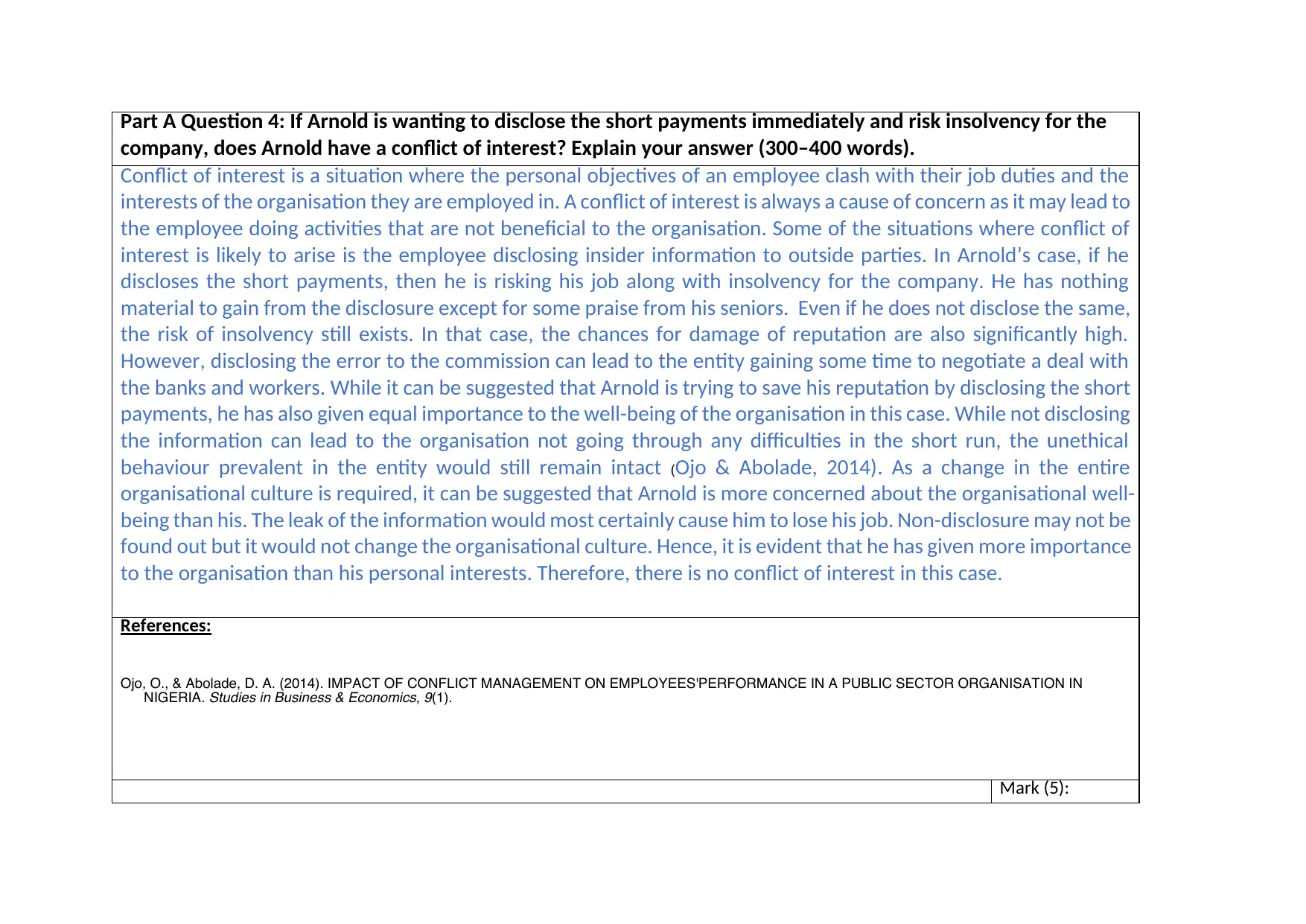
Part A Question 4: If Arnold is wanting to disclose the short payments immediately and risk insolvency for the
company, does Arnold have a conflict of interest? Explain your answer (300–400 words).
Conflict of interest is a situation where the personal objectives of an employee clash with their job duties and the
interests of the organisation they are employed in. A conflict of interest is always a cause of concern as it may lead to
the employee doing activities that are not beneficial to the organisation. Some of the situations where conflict of
interest is likely to arise is the employee disclosing insider information to outside parties. In Arnold’s case, if he
discloses the short payments, then he is risking his job along with insolvency for the company. He has nothing
material to gain from the disclosure except for some praise from his seniors. Even if he does not disclose the same,
the risk of insolvency still exists. In that case, the chances for damage of reputation are also significantly high.
However, disclosing the error to the commission can lead to the entity gaining some time to negotiate a deal with
the banks and workers. While it can be suggested that Arnold is trying to save his reputation by disclosing the short
payments, he has also given equal importance to the well-being of the organisation in this case. While not disclosing
the information can lead to the organisation not going through any difficulties in the short run, the unethical
behaviour prevalent in the entity would still remain intact (Ojo & Abolade, 2014). As a change in the entire
organisational culture is required, it can be suggested that Arnold is more concerned about the organisational well-
being than his. The leak of the information would most certainly cause him to lose his job. Non-disclosure may not be
found out but it would not change the organisational culture. Hence, it is evident that he has given more importance
to the organisation than his personal interests. Therefore, there is no conflict of interest in this case.
References:
Ojo, O., & Abolade, D. A. (2014). IMPACT OF CONFLICT MANAGEMENT ON EMPLOYEES'PERFORMANCE IN A PUBLIC SECTOR ORGANISATION IN
NIGERIA. Studies in Business & Economics, 9(1).
Mark (5):
company, does Arnold have a conflict of interest? Explain your answer (300–400 words).
Conflict of interest is a situation where the personal objectives of an employee clash with their job duties and the
interests of the organisation they are employed in. A conflict of interest is always a cause of concern as it may lead to
the employee doing activities that are not beneficial to the organisation. Some of the situations where conflict of
interest is likely to arise is the employee disclosing insider information to outside parties. In Arnold’s case, if he
discloses the short payments, then he is risking his job along with insolvency for the company. He has nothing
material to gain from the disclosure except for some praise from his seniors. Even if he does not disclose the same,
the risk of insolvency still exists. In that case, the chances for damage of reputation are also significantly high.
However, disclosing the error to the commission can lead to the entity gaining some time to negotiate a deal with
the banks and workers. While it can be suggested that Arnold is trying to save his reputation by disclosing the short
payments, he has also given equal importance to the well-being of the organisation in this case. While not disclosing
the information can lead to the organisation not going through any difficulties in the short run, the unethical
behaviour prevalent in the entity would still remain intact (Ojo & Abolade, 2014). As a change in the entire
organisational culture is required, it can be suggested that Arnold is more concerned about the organisational well-
being than his. The leak of the information would most certainly cause him to lose his job. Non-disclosure may not be
found out but it would not change the organisational culture. Hence, it is evident that he has given more importance
to the organisation than his personal interests. Therefore, there is no conflict of interest in this case.
References:
Ojo, O., & Abolade, D. A. (2014). IMPACT OF CONFLICT MANAGEMENT ON EMPLOYEES'PERFORMANCE IN A PUBLIC SECTOR ORGANISATION IN
NIGERIA. Studies in Business & Economics, 9(1).
Mark (5):
Paraphrase This Document
Need a fresh take? Get an instant paraphrase of this document with our AI Paraphraser
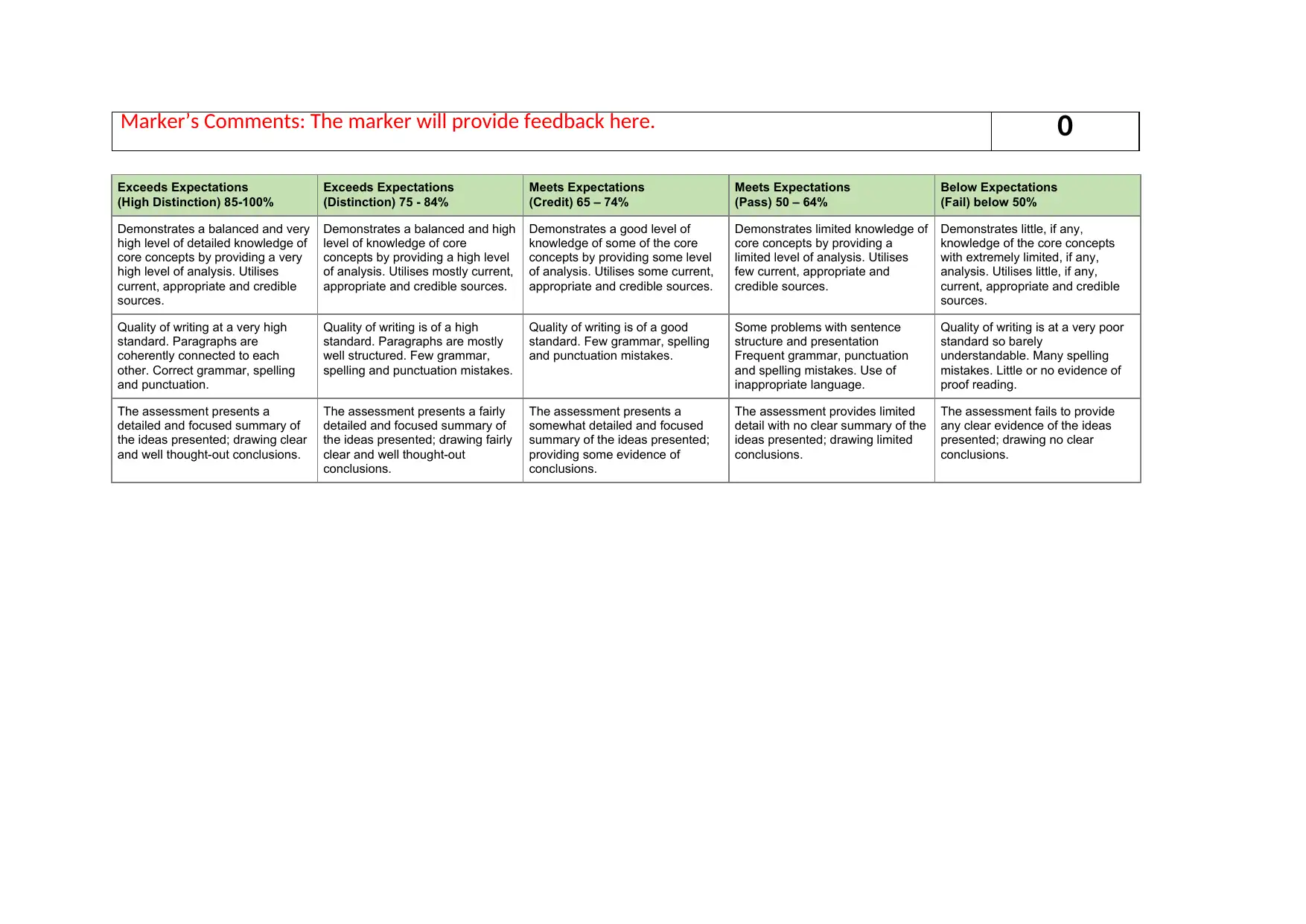
Marker’s Comments: The marker will provide feedback here. 0
Exceeds Expectations
(High Distinction) 85-100%
Exceeds Expectations
(Distinction) 75 - 84%
Meets Expectations
(Credit) 65 – 74%
Meets Expectations
(Pass) 50 – 64%
Below Expectations
(Fail) below 50%
Demonstrates a balanced and very
high level of detailed knowledge of
core concepts by providing a very
high level of analysis. Utilises
current, appropriate and credible
sources.
Demonstrates a balanced and high
level of knowledge of core
concepts by providing a high level
of analysis. Utilises mostly current,
appropriate and credible sources.
Demonstrates a good level of
knowledge of some of the core
concepts by providing some level
of analysis. Utilises some current,
appropriate and credible sources.
Demonstrates limited knowledge of
core concepts by providing a
limited level of analysis. Utilises
few current, appropriate and
credible sources.
Demonstrates little, if any,
knowledge of the core concepts
with extremely limited, if any,
analysis. Utilises little, if any,
current, appropriate and credible
sources.
Quality of writing at a very high
standard. Paragraphs are
coherently connected to each
other. Correct grammar, spelling
and punctuation.
Quality of writing is of a high
standard. Paragraphs are mostly
well structured. Few grammar,
spelling and punctuation mistakes.
Quality of writing is of a good
standard. Few grammar, spelling
and punctuation mistakes.
Some problems with sentence
structure and presentation
Frequent grammar, punctuation
and spelling mistakes. Use of
inappropriate language.
Quality of writing is at a very poor
standard so barely
understandable. Many spelling
mistakes. Little or no evidence of
proof reading.
The assessment presents a
detailed and focused summary of
the ideas presented; drawing clear
and well thought-out conclusions.
The assessment presents a fairly
detailed and focused summary of
the ideas presented; drawing fairly
clear and well thought-out
conclusions.
The assessment presents a
somewhat detailed and focused
summary of the ideas presented;
providing some evidence of
conclusions.
The assessment provides limited
detail with no clear summary of the
ideas presented; drawing limited
conclusions.
The assessment fails to provide
any clear evidence of the ideas
presented; drawing no clear
conclusions.
Exceeds Expectations
(High Distinction) 85-100%
Exceeds Expectations
(Distinction) 75 - 84%
Meets Expectations
(Credit) 65 – 74%
Meets Expectations
(Pass) 50 – 64%
Below Expectations
(Fail) below 50%
Demonstrates a balanced and very
high level of detailed knowledge of
core concepts by providing a very
high level of analysis. Utilises
current, appropriate and credible
sources.
Demonstrates a balanced and high
level of knowledge of core
concepts by providing a high level
of analysis. Utilises mostly current,
appropriate and credible sources.
Demonstrates a good level of
knowledge of some of the core
concepts by providing some level
of analysis. Utilises some current,
appropriate and credible sources.
Demonstrates limited knowledge of
core concepts by providing a
limited level of analysis. Utilises
few current, appropriate and
credible sources.
Demonstrates little, if any,
knowledge of the core concepts
with extremely limited, if any,
analysis. Utilises little, if any,
current, appropriate and credible
sources.
Quality of writing at a very high
standard. Paragraphs are
coherently connected to each
other. Correct grammar, spelling
and punctuation.
Quality of writing is of a high
standard. Paragraphs are mostly
well structured. Few grammar,
spelling and punctuation mistakes.
Quality of writing is of a good
standard. Few grammar, spelling
and punctuation mistakes.
Some problems with sentence
structure and presentation
Frequent grammar, punctuation
and spelling mistakes. Use of
inappropriate language.
Quality of writing is at a very poor
standard so barely
understandable. Many spelling
mistakes. Little or no evidence of
proof reading.
The assessment presents a
detailed and focused summary of
the ideas presented; drawing clear
and well thought-out conclusions.
The assessment presents a fairly
detailed and focused summary of
the ideas presented; drawing fairly
clear and well thought-out
conclusions.
The assessment presents a
somewhat detailed and focused
summary of the ideas presented;
providing some evidence of
conclusions.
The assessment provides limited
detail with no clear summary of the
ideas presented; drawing limited
conclusions.
The assessment fails to provide
any clear evidence of the ideas
presented; drawing no clear
conclusions.
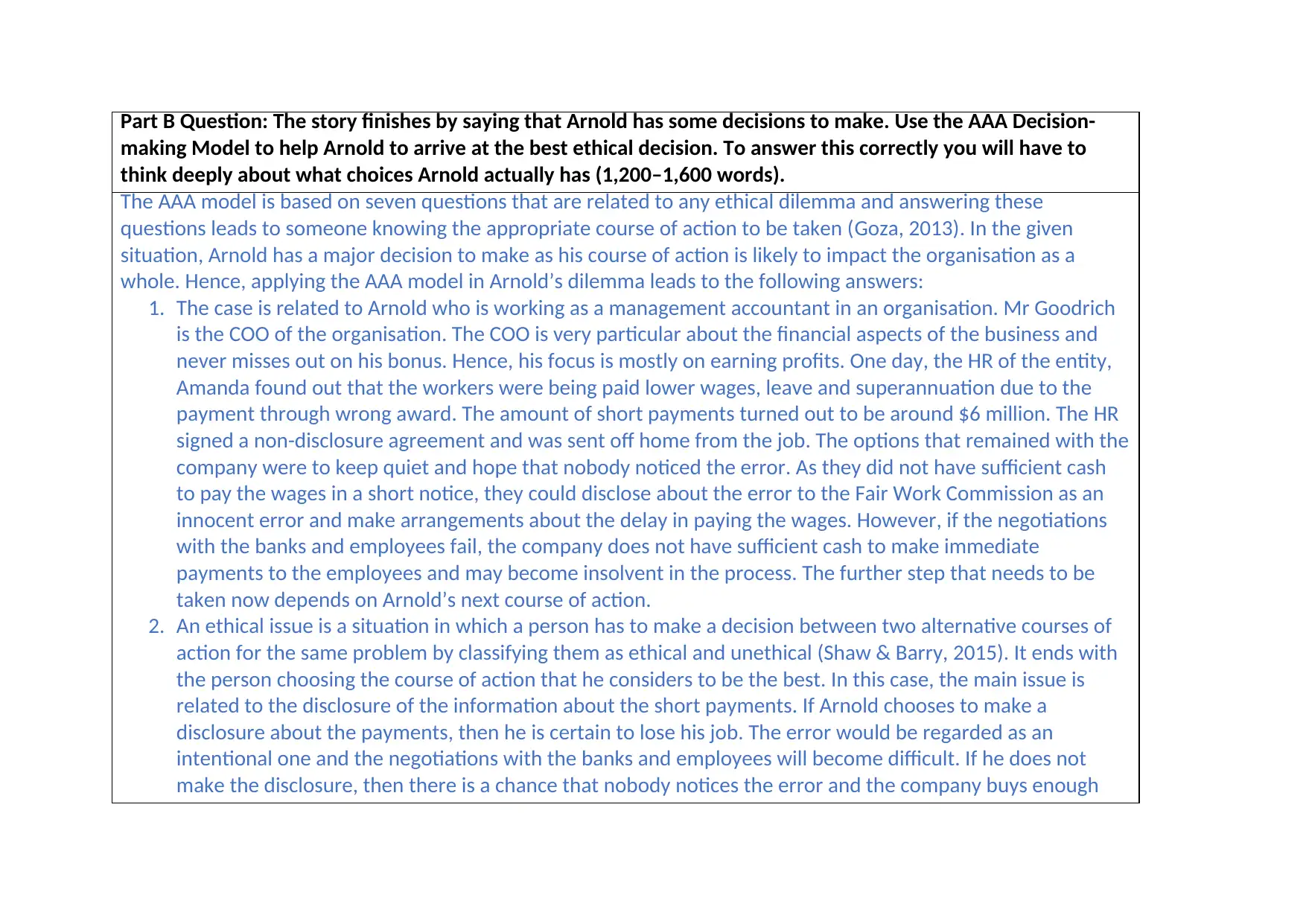
Part B Question: The story finishes by saying that Arnold has some decisions to make. Use the AAA Decision-
making Model to help Arnold to arrive at the best ethical decision. To answer this correctly you will have to
think deeply about what choices Arnold actually has (1,200–1,600 words).
The AAA model is based on seven questions that are related to any ethical dilemma and answering these
questions leads to someone knowing the appropriate course of action to be taken (Goza, 2013). In the given
situation, Arnold has a major decision to make as his course of action is likely to impact the organisation as a
whole. Hence, applying the AAA model in Arnold’s dilemma leads to the following answers:
1. The case is related to Arnold who is working as a management accountant in an organisation. Mr Goodrich
is the COO of the organisation. The COO is very particular about the financial aspects of the business and
never misses out on his bonus. Hence, his focus is mostly on earning profits. One day, the HR of the entity,
Amanda found out that the workers were being paid lower wages, leave and superannuation due to the
payment through wrong award. The amount of short payments turned out to be around $6 million. The HR
signed a non-disclosure agreement and was sent off home from the job. The options that remained with the
company were to keep quiet and hope that nobody noticed the error. As they did not have sufficient cash
to pay the wages in a short notice, they could disclose about the error to the Fair Work Commission as an
innocent error and make arrangements about the delay in paying the wages. However, if the negotiations
with the banks and employees fail, the company does not have sufficient cash to make immediate
payments to the employees and may become insolvent in the process. The further step that needs to be
taken now depends on Arnold’s next course of action.
2. An ethical issue is a situation in which a person has to make a decision between two alternative courses of
action for the same problem by classifying them as ethical and unethical (Shaw & Barry, 2015). It ends with
the person choosing the course of action that he considers to be the best. In this case, the main issue is
related to the disclosure of the information about the short payments. If Arnold chooses to make a
disclosure about the payments, then he is certain to lose his job. The error would be regarded as an
intentional one and the negotiations with the banks and employees will become difficult. If he does not
make the disclosure, then there is a chance that nobody notices the error and the company buys enough
making Model to help Arnold to arrive at the best ethical decision. To answer this correctly you will have to
think deeply about what choices Arnold actually has (1,200–1,600 words).
The AAA model is based on seven questions that are related to any ethical dilemma and answering these
questions leads to someone knowing the appropriate course of action to be taken (Goza, 2013). In the given
situation, Arnold has a major decision to make as his course of action is likely to impact the organisation as a
whole. Hence, applying the AAA model in Arnold’s dilemma leads to the following answers:
1. The case is related to Arnold who is working as a management accountant in an organisation. Mr Goodrich
is the COO of the organisation. The COO is very particular about the financial aspects of the business and
never misses out on his bonus. Hence, his focus is mostly on earning profits. One day, the HR of the entity,
Amanda found out that the workers were being paid lower wages, leave and superannuation due to the
payment through wrong award. The amount of short payments turned out to be around $6 million. The HR
signed a non-disclosure agreement and was sent off home from the job. The options that remained with the
company were to keep quiet and hope that nobody noticed the error. As they did not have sufficient cash
to pay the wages in a short notice, they could disclose about the error to the Fair Work Commission as an
innocent error and make arrangements about the delay in paying the wages. However, if the negotiations
with the banks and employees fail, the company does not have sufficient cash to make immediate
payments to the employees and may become insolvent in the process. The further step that needs to be
taken now depends on Arnold’s next course of action.
2. An ethical issue is a situation in which a person has to make a decision between two alternative courses of
action for the same problem by classifying them as ethical and unethical (Shaw & Barry, 2015). It ends with
the person choosing the course of action that he considers to be the best. In this case, the main issue is
related to the disclosure of the information about the short payments. If Arnold chooses to make a
disclosure about the payments, then he is certain to lose his job. The error would be regarded as an
intentional one and the negotiations with the banks and employees will become difficult. If he does not
make the disclosure, then there is a chance that nobody notices the error and the company buys enough
⊘ This is a preview!⊘
Do you want full access?
Subscribe today to unlock all pages.

Trusted by 1+ million students worldwide
1 out of 15
Your All-in-One AI-Powered Toolkit for Academic Success.
+13062052269
info@desklib.com
Available 24*7 on WhatsApp / Email
![[object Object]](/_next/static/media/star-bottom.7253800d.svg)
Unlock your academic potential
Copyright © 2020–2025 A2Z Services. All Rights Reserved. Developed and managed by ZUCOL.
